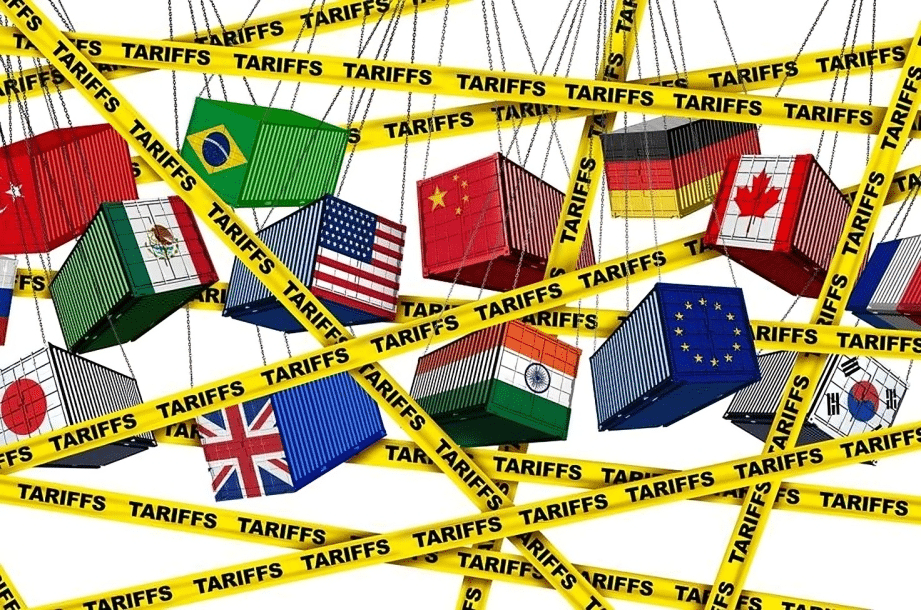The Impact of Global Tariff Wars on Ford Stock’s Dividend Safety
The global tariff wars have created significant upheaval in markets all around the world, and it’s only natural for investors to question whether Ford Motor Company’s dividend remains safe amid these tensions. With Ford stock historically delivering reliable dividends, many are closely monitoring how rising tariffs on steel, aluminum, and other materials impact the company’s profitability and, ultimately, its ability to maintain its dividend payouts. Here’s what you need to know.
Ford is not just any automaker; it has a long-standing tradition of returning value to its shareholders through dividends. However, the recent landscape of added tariffs can complicate things. Tariffs raise the cost of raw materials, leading to increased production costs for companies like Ford. This trend can put pressure on profit margins, a key factor in sustaining dividend payments.
So how do tariffs affect Ford specifically? The following points highlight crucial factors to consider:
- Increased Costs: Imposed tariffs on imported materials like steel and aluminum can dramatically elevate Ford’s manufacturing expenses.
- Profit Margins: Higher production costs can erode Ford’s profit margins, which may force the company to rethink its dividend policy.
- Sales Strategies: As costs rise, Ford may adjust pricing strategies. This, in turn, could impact demand for their vehicles.
- Shareholder Expectations: Long-term investors expect dividends, and a deviation from consistent growth can lead to negative market reactions.
Investors should evaluate how Ford is responding to these potential pressures. The company is actively seeking ways to mitigate tariff impacts. For instance, Ford has invested in technology to enhance production efficiency. By streamlining operations and lowering manufacturing costs in other areas, Ford can offset increased material expenses. Additionally, they might consider sourcing materials locally to avoid tariffs, even if it comes at a higher initial setup cost.
Market analysts have differing opinions on Ford’s dividend safety during this tumultuous period. Several key factors contribute to their forecasts:
- Strong Cash Flow: Ford has shown a resilient cash flow over the years. A healthy cash reserve can support dividend payouts despite fluctuating earnings.
- Debt Levels: Investors should consider Ford’s current debt levels. High debt could jeopardize financial flexibility during challenging economic conditions.
- Global Demand: If global economic conditions weaken due to ongoing trade wars, vehicle demand may diminish, which will also impact revenue streams.
On the other hand, there are indicators suggesting Ford’s dividend remains intact. CEO Jim Farley has expressed a commitment to maintaining the dividend as part of their strategy to be shareholder-friendly. This commitment reflects Ford’s historical ethos—returning value to investors even during tough times.
Trade relations are evolving, and Ford is closely monitoring changes in tariffs and trade agreements. Recent talks around tariff reductions could lift the pressure on their production costs, allowing Ford to better protect its dividend. Engaging in negotiations and lobbying for favorable tariffs demonstrates that Ford is proactive in safeguarding shareholder interests.
To gauge Ford’s stock for a potential investment, consider these elements:
- Watch Tariff Developments: Keep an eye on news regarding international trade and emerging tariffs.
- Review Earnings Reports: Regularly check Ford’s quarterly earnings reports to see how costs and profits are trending.
- Analyze Cash Reserves: Ensure that Ford is maintaining a strong balance sheet capable of sustaining dividends.
- Explore Market Reactions: Pay attention to how the market is reacting to news about tariffs and Ford’s stock.
While the global tariff war puts Ford’s dividend under scrutiny, the automaker’s proactive strategies and commitment to shareholder returns are promising signs. Understanding the complexities of the current economic climate can help you make informed decisions regarding Ford stock and its dividend safety. Remember, staying engaged and up-to-date with market news is critical in navigating these uncertain waters.
Strategies to Assess Dividend Sustainability in Volatile Markets
Investing in dividend-paying stocks can be appealing, especially during uncertain economic times. With markets becoming increasingly volatile, understanding how to assess the sustainability of dividends is crucial for investors. Here are some essential strategies to help you determine whether dividend payouts are likely to remain stable, even in challenging environments.
Evaluate the Payout Ratio
The payout ratio represents the percentage of a company’s earnings paid out as dividends to shareholders. A lower payout ratio often indicates that a company has room to maintain or grow its dividend, while a higher ratio might signal vulnerability, especially during downturns.
- Check if the payout ratio is below 60%—this often suggests a healthy balance between reinvesting in the business and returning value to shareholders.
- A rapidly increasing payout ratio may warrant caution, as it could indicate the company is stretching itself thin.
Analyze Cash Flow
While earnings provide a glimpse into a company’s profitability, cash flow offers a clear picture of its liquidity. It’s vital to ensure that a company’s operational cash flow covers its dividend payouts.
- Look for operating cash flow that exceeds the dividend payments, indicating that the company can comfortably support its dividends.
- Monitoring free cash flow is also important, as it shows how much cash is available after capital expenditures, which is necessary for maintaining long-term sustainability.
Examine Company Balance Sheet Strength
A robust balance sheet is a critical factor in assessing a company’s dividend sustainability. Strong assets and low debt levels provide insulation against economic storms.
- Prefer companies with low debt-to-equity ratios, as they are in a better position to absorb potential declines in revenue without cutting dividends.
- Check liquidity ratios, such as the current ratio and quick ratio, to ensure the company can easily meet short-term obligations.
Look for Historical Dividend Growth
A company’s track record regarding dividends is a good indicator of what to expect in the future. Companies that have consistently increased their dividends over time are often more reliable.
- Investors should consider those with a history of dividend growth, especially during economic downturns, as this demonstrates commitment and financial resilience.
- Assess the number of consecutive years a company has paid dividends, especially in challenging market conditions, indicating reliability.
Assess Industry Conditions
Different industries respond uniquely to market fluctuations. Understanding the industry dynamics can significantly inform your analysis of dividend sustainability.
- Evaluate how economic cycles impact the industry. For instance, consumer staples tend to be more resilient during downturns compared to luxury goods.
- Look for trends such as innovation or regulatory changes that could affect a company’s ability to maintain its dividend.
Monitor Economic Indicators
Economic health can directly affect dividend payments. Keep an eye on key indicators such as interest rates, unemployment rates, and GDP growth, which can provide context around the broader market climate.
- Changes in interest rates can influence a company’s borrowing costs, affecting profitability and, subsequently, dividend payments.
- High unemployment rates can lead to reduced consumer spending, impacting sales and earnings, which may force companies to reevaluate dividend policies.
Stay Updated with Management Commentary
Management’s viewpoint on how the business is faring can be telling. Regular updates from company leadership—during earnings calls, for example—can provide insights into future strategies and potential dividend changes.
- Listen for comments related to business outlooks and expected challenges, as management’s confidence in the company can be insightful for investors.
- Pay attention to any signals regarding capital expenditures or shifts in business strategy which may impact dividend sustainability.
Monitoring the factors outlined above can enhance your ability to assess dividend sustainability in volatile markets. By focusing on the fundamentals while keeping a watchful eye on larger economic indicators, you can make more informed investment decisions that align with your financial goals.
Conclusion
As Ford navigates the complexities of global tariff wars, understanding the potential risks to its juicy dividend becomes crucial for investors. The ongoing conflict can lead to increased production costs and uncertainty in profit margins, impacting the company’s ability to maintain its dividend payouts. Utilizing a comprehensive approach to assess Ford’s dividend sustainability is essential in these volatile economic circumstances.
One effective strategy involves closely monitoring the company’s cash flow and earnings reports, as a strong financial foundation is vital for sustaining dividends during tough times. Investors should also heed any news regarding trade policies and economic forecasts that could further influence Ford’s operations. Diversifying investments and staying informed about the automotive industry’s evolving landscape can also serve as a buffer against potential downturns.
Ultimately, while Ford stock currently boasts a juicy dividend, ongoing vigilance is necessary. Investors must be proactive in recognizing both the opportunities and risks presented by global tariff wars. Balancing short-term fluctuations against long-term potential can help you make informed decisions about your investments. By employing these strategies, you can better understand whether Ford’s dividend remains a safe harbor or if it’s time to reevaluate your position in light of external economic pressures. Staying informed and adaptable will empower you to navigate the uncertainties ahead in this dynamic market.
Comparison, examination, and analysis between investment houses
Leave your details, and an expert from our team will get back to you as soon as possible
* This article, in whole or in part, does not contain any promise of investment returns, nor does it constitute professional advice to make investments in any particular field.
To read more about the full disclaimer, click here- sagi habasov
- •
- 7 Min Read
- •
- ago 46 minutes
 Australia’s Job Market Rebounds in July as Unemployment Rate Eases
Australia’s Job Market Rebounds in July as Unemployment Rate Eases
Australia’s labor market showed renewed strength in July, delivering a welcome boost to the nation’s economic outlook. Fresh employment data
- ago 46 minutes
- •
- 7 Min Read
Australia’s labor market showed renewed strength in July, delivering a welcome boost to the nation’s economic outlook. Fresh employment data
- Lior mor
- •
- 8 Min Read
- •
- ago 58 minutes
 Chinese Investors Turn to Indonesia to Sidestep U.S. Tariffs and Access Growing Local Market
Chinese Investors Turn to Indonesia to Sidestep U.S. Tariffs and Access Growing Local Market
Rising Interest from Chinese Businesses in Southeast Asia Chinese companies are increasingly shifting their focus to Indonesia as they seek
- ago 58 minutes
- •
- 8 Min Read
Rising Interest from Chinese Businesses in Southeast Asia Chinese companies are increasingly shifting their focus to Indonesia as they seek
- sagi habasov
- •
- 8 Min Read
- •
- ago 1 hour
 Dollar Weakens Amid Fed Rate-Cut Speculation While Bitcoin Hits All-Time High
Dollar Weakens Amid Fed Rate-Cut Speculation While Bitcoin Hits All-Time High
The U.S. dollar has fallen to multi-month lows as market expectations for Federal Reserve interest rate cuts intensify, while Bitcoin
- ago 1 hour
- •
- 8 Min Read
The U.S. dollar has fallen to multi-month lows as market expectations for Federal Reserve interest rate cuts intensify, while Bitcoin
- orshu
- •
- 7 Min Read
- •
- ago 2 hours
 Oil Prices Surge from Two-Month Lows Ahead of Trump-Putin Summit
Oil Prices Surge from Two-Month Lows Ahead of Trump-Putin Summit
Global oil markets have rebounded after sliding to two-month lows, as investors prepare for the highly anticipated meeting between former
- ago 2 hours
- •
- 7 Min Read
Global oil markets have rebounded after sliding to two-month lows, as investors prepare for the highly anticipated meeting between former












